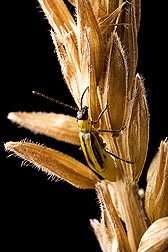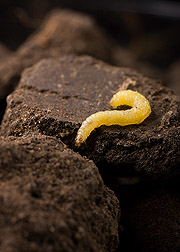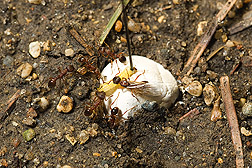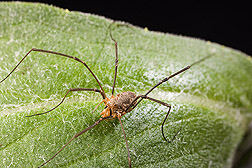Predators Can Be a Farmer’s Best Friend
|
|
One of the worst pests of corn in the world, the corn rootworm, may owe its success partly to its larvae’s very sticky blood.
Jonathan G. Lundgren, an entomologist at the Agricultural Research Service’s North Central Agricultural Research Laboratory in Brookings, South Dakota, and colleagues discovered this recently, working with CABI researchers in Switzerland and Hungary.
CABI is an international, not-for-profit, science-based, development and information organization that researches natural ways of controlling pests, and it has been helping to lead the effort against corn rootworm’s European invasion.
The work with CABI involved 2 years of laboratory and field experiments, begun in 2007, in the United States and Hungary. The experiments are the latest in Lundgren’s research on corn rootworm predators, which began 5 years ago. Although rootworms have been a major pest for 100 years, this is—remarkably—the first comprehensive research program on corn rootworm predators to be conducted.
|
|
Sticky Blood Shuts Down Would-Be Rootworm Predators
In the Brookings laboratory, Lundgren and colleagues offered hungry predators (from formidable ground beetles to wolf spiders to ants) a smorgasbord of rootworm larvae and pupae. In all, they have tested 10 different predator species from Europe and North America, including beetles native to central Europe and those native to the Midwest and Great Plains of the United States.
The rootworms came from the Brookings lab’s world-class rootworm-rearing facility.
The predators aggressively attacked the squirming rootworm larvae and immobile pupae at first. They wolfed down the pupae. But immediately after attacking the larvae, some of the predators quickly retreated and began vigorously cleaning their mouths, which had been glued shut by coagulated rootworm blood. The coagulation is the prey’s attempt to heal its wounds from the predator’s first bite—as well as to give its predator something else to chew on.
|
|
Blood Defense One Key to Rootworm Success in Corn Fields
The ability of rootworm larvae to fend off predators may be a major reason for their success in corn fields. But luckily, not all predators are easily chased off by the rootworm larvae.
While the rootworm larvae repelled all the predators under laboratory conditions, the blood had varying effects on different species.
The sticky blood was most effective against two common species of ground beetles, Harpalus pensylvanicus and H. rufipes. They did not return for a second try during the 10-minute observation period, nor did the ants or the Carabus monilis ground beetle.
Beetles belonging to three of the most voracious predatory beetle species returned almost immediately to have another go at their adversary. They are Pterostichus anthracinus, Pt. melanarius, and Poecilus cupreus.
|
|
Chemoreceptors Are Nice To Have
One of the beetle species that did not return has such long mandibles that the rootworm blood never even reached its mouth, indicating that chemoreceptors in the beetle’s external mouthparts—rather than rootworm blood—made them decide against eating the rootworms.
An attacking ant, or the blood itself, cued her sisters in to the repellent rootworm blood such that once an ant attacked, none of her sisters would touch it.
Wolf spiders on the other hand hardly ever left their prey unattended, repeatedly biting the rootworms until the larvae were consumed.
|
|
Field Tests Confirm Predators Prefer Maggots to Rootworms
Field tests in a Hungarian corn field, over the same 2-year period, showed similar results as the lab experiments, but the repulsion and avoidance weren’t as extreme.
The scientists pinned mature rootworms and fly maggots (a known favorite prey item for many predators) in place at the base of corn plants and periodically observed their condition throughout the day and night. They also looked for attacking predators. They found that substantially more predators attacked the fly maggots than attacked the rootworms.
Back in South Dakota, Lundgren and colleagues seeded a no-till corn field with rootworm eggs, at the rate of 1,000 eggs per foot of crop row, then captured the predators that came hunting. Scientists collected 1,500 predators of more than 80 species. By searching for rootworm DNA in their guts, Lundgren found that predators with sucking mouthparts (especially spiders, harvestmen, and mites) ate more rootworms than any of the other predators tested.
|
|
“This showed that sucking predators, such as wolf spiders, are better suited to eating rootworms than are chewing insects, such as beetles,” Lundgren says. He adds that he now suspects the rootworm defense is the reason. “When insects suck fluids, they may be able to bypass the ability of the blood to stick and linger,” he says.
The scientists also found that, besides spiders, harvestmen, and small rove beetles, two species of ground beetles (Scarites quadriceps and P. chalcites) and mites were the most common predators of rootworm larvae and eggs.
Lundgren says his whole approach is “managing crop fields to encourage large and diverse predator populations. This can be done by reducing or eliminating tillage and pesticide use and diversifying vegetation.”
Cover Crop Can Help Predators and Farmers Win
Armed with this information, and knowing the pest he is up against, Lundgren began to manipulate corn fields to try to encourage predators to eat more of the repellent larvae. In a separate 3-year study, Lundgren found that a winter cover crop (slender wheatgrass) increases the number of predators so dramatically that there are few corn rootworms left to eat the roots of corn seedlings when they sprout. This study is ongoing, and Lundgren is working with an economist to determine whether the cover crop can compete economically with using Bt corn or other pesticides to control the rootworms.
|
|
Over the long term, Lundgren is considering the idea of “knocking out” the rootworm genes responsible for their defense, to make the insects even more susceptible to predators.
“Future research will help to address how the rootworm’s defenses contribute to its success as an invasive pest and to develop ways to overcome these defenses in search of sustainable, ecologically based pest management,” he says.—By Don Comis, Agricultural Research Service Information Staff.
This research is part of Crop Protection and Quarantine (#304), an ARS national program described at www.nps.ars.usda.gov.
Jonathan G. Lundgren is with the USDA-ARS North Central Agricultural Research Laboratory, 2923 Medary Ave., Brookings, SD 57006; (605) 593-5211.
"Predators Can Be a Farmer’s Best Friend" was published in the November/December 2010 issue of Agricultural Research magazine.













